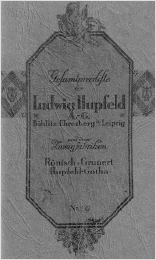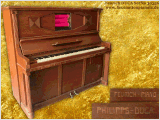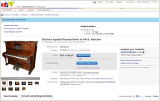Prices of pianolas
Only very moneyed members of the growing upper middle class or the rich and very rich upper classes could afford a pianola and additional piano rolls. If you consider that in 1910, more than 40 % of the population earned less than 900 Marks per year and most of the other 60 % less than 3,000 Marks, while living required approx. 1,500 Marks for a single person of everyday demands, the prices of the pianolas will show very quickly that only very few persons could really afford such a system. It was luxury. Yet all manufacturers managed to distinctly profit from the prosperity, driven by industrialization, of more and more households, so that the production of pianolas was between 1908 and 1920 one of the most important trades.
Some data on prices from original catalogs of contemporary manufacturers follow to give an idea:
Price in 1904 of an Aeolian 65 note pianola push-up player: ~1.250 Mark
Price in 1904 of a Hupfeld Phonola push-up player: ~850 Mark
Price in 1908 of a Spaethe pianist pianola piano: 1,850 Mark
Price in 1910 of a Buff-Hedinger Feurich pianola piano: 2,100 Mark
Price in 1910 of a Buff-Hedinger Feurich pianola grand: more than 3,400 Mark
Price in 1911 of a Welte-Mignon push-up player: ~2,100 Mark
Price in 1911 of a Philipps DUCA/Pianella concert piano: 3,600 Mark
Price in 1912 of a Hupfeld DEA Rönisch grand (2.15 m): 6,500 Mark
Price in 1925 of a Hupfeld Triphonola Rönisch grand: 10,900 Mark
Price in 1929 of a Hupfeld Triphonola Schiedmayer & sons grand piano: 5,950 Mark
Pricing Feurich Philipps Duca inflation
Pricing of Feurich Philipps Duca in times of inflation...
One interesting detail taken from the Feurich sales books is the development of prices during inflation. However we haven't seen all the sales books yet, here is a first insight for one of the best selling Feurich Duca pianos (oak, untreated, Mod III):
Date of sale price
01Sep1915 746
22May1916 818
27Nov1916 895
24Jun1918 2.170
26Apr1920 2.400
07Jun1920 3.600
12Jan1921 7.100
27Jan1921 9.600
23Apr1921 15.110
31.Dez1921 12.600
01May1922 42.000
05Jul1922 55.000
07Jul1922 49.500
31Aug1922 102.000
07Feb1923 4.995.000
26May1923 8.050.000
10Sep1923 22.313.367.925
24Sep1923 39.243.623.000
Priceslists of pianolas
| Klicken Sie hier, um zur Galerie zu gelangen. |
Advertisements of used pianolas
Of course the prices were influenced by many factors during the difficult market situation (WWI, economic crisis, currency fluctuations/inflation, competition of many manufacturers ...) of the late 1910s and the 1920s. In reality, prices could deviate from those stated in the price-lists. Even good and cheap second-hand instruments with an interesting piano roll repertoire became increasingly available, as suggested by the announcement from the Zeitschrift für Instrumentenbau, 1929, shown below.
CEUS project and price levels
The average annual income in Germany is nowadays approx. 36,000 euro. The reproduction systems of Welte, Philipps and Hupfeld were the spearhead of available technology in Germany at that time; today, Bösendorfer's CEUS system and Steinways Spirio may be perhaps compared. The expenses for a CEUS system integrated into a Bösendorfer grand piano amount to some 40,000 euro (without the grand) - the estimated investment into a reproduction instrument thus is still one average annual income.
On the second-hand market of pianolas, the prices are today at a quite low level, following a climax during the 1980s. A refurnished (well playable, with existing structure) pianola requires a purchase price in the range of 2,500 – 5,000 euro. A completely restored (complete, authentic renewal) pianola of the "artistic piano" style is found in the range of 5,000 – 10,000 €. A high grade restored reproduction instrument costs, in my experience, between 10,000 and 25,000 euro, according to design and manufacturer. Unique pieces and special designs may be considerably more expensive - and yet will cost only a fraction of the investment that had been necessary back then (approx. 7 average annual incomes).









